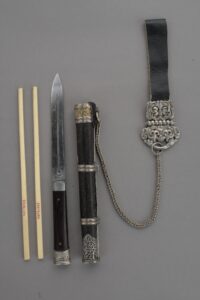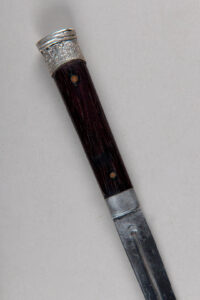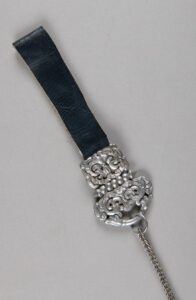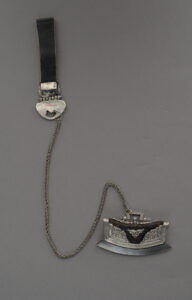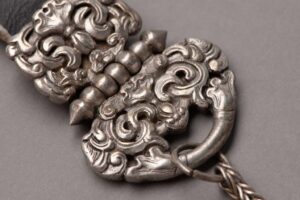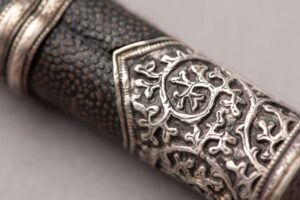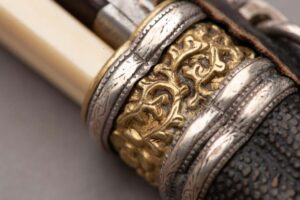A shepherd’s set from Mongolia
Every month curators of the Asia and Pacific Museum carefully select one object representing various parts of our new permanent exhibition Journeys to the east through the cultures of the Middle East, Central Asia, Mongolia and Indonesia.
In February we pay particular attention to a shepherd’s set from Mongolia consisting of a tinder pouch, combined with a knife with bone chopsticks for eating meals. Both the tinder pouch and the knife are suspended on decorative chains with a loop, to a wide, Mongolian belt.
Tinder pouch (mong. khet) – a flat, leather bag for pieces of flint and flammable material (e.g. bark) – is permanently connected to a slightly bent steel bar, the fire starter. From the collision of the steel set (held in the right hand) and a flint with tinder (in the left one), sparks are created, and the dry, flammable material takes fire.
The pouch has the shape of a trapezoidal envelope with a flap. It is decorated with diagonal, crossing lines embossed in its surface and with silver fittings with a repoussé floral pattern. A chain loop is attached at the top of the pouch.
Knife (mong. khutga) has a narrow but massive, single-edged blade. The grip is straight, with an oval cross-section, made of brown wood claddings attached with copper rivets to a steel tongue (the pin protruding from the blade). At the upper end is a small silver cap with a repoussé ornament of plant twigs. Sheath, 19.5 cm long, consists of two channels: one for the knife, the other for two bone sticks. The sheath is made of wood and covered with black, grained shagreen leather. It is decorated with fittings: the upper one is made of brass and silver rings with repoussé plant decoration (on brass surface only); the lower one is made of silver and decorated analogically; also there are two double silver rings. The fittings are fastened with rivets, and the joints are hidden at the back of the sheath, on a narrow, silver strip connecting the upper and bottom end of the sheath. In addition to the mentioned fittings – structural elements of the sheath – there are two decorative silver plaques: a gourd-like one and an oval medallion with the Chinese character shou – a symbol of longevity – engraved on it. The chopsticks for eating meals, 20.5 cm in length, are made of bone, slightly tapered downwards, have square cross-section. No patterns.
The flint-set pouch and the knife are suspended on thick, silver chains (the longer one is at the tinder-pouch). At the upper ends there are decorative hinged pendants, from which, in turn, leather loops (of black leather) protrude, for hanging both items on the belt. The hinged pendants are – each – composed of two segments. The upper is rectangular, the lower one is oval. The pendants were made in the technique of casting; they are decorated with a floral pattern in relief.
In the conditions of nomadic life in the steppe a tinder pouch and a knife, was the basic element of a shepherd’s equipment. Similar sets were known also in Manchuria and Tibet, slightly differing in proportions and details.
In Mongolia such a set was the mark of a man. It was funded by the father to his son when he reached adulthood. The degree of ornamentation depended on the wealth of a given family.
Shepherd’s set: fire starter with knife
Mongolia, 1st quarter of the 20th century
steel, wood, leather, silver, bone
dimensions: length 59.8 cm (set); tinder pouch: 6 x 11 cm; knife lenght: 22.5 cm
inv. no. MAiP 13043

![grafika z tekstem [journeys to the east]](https://www.muzeumazji.pl/maip/uploads/2022/08/baner_strona_english_tn-1140x220.jpg)


